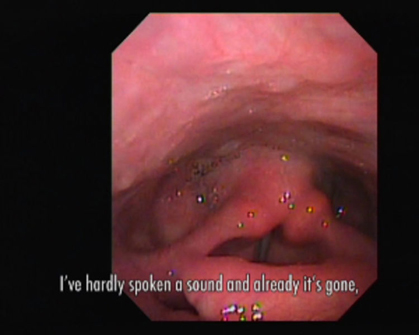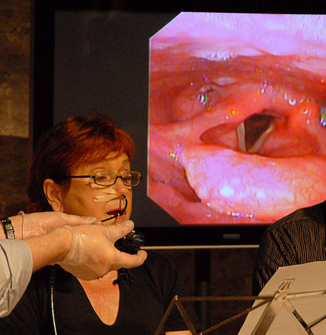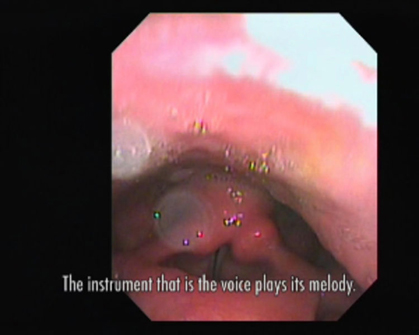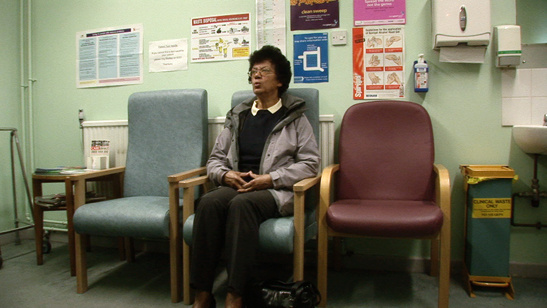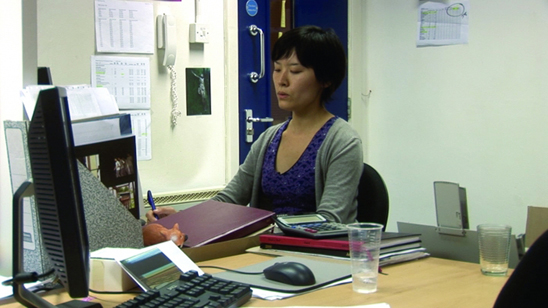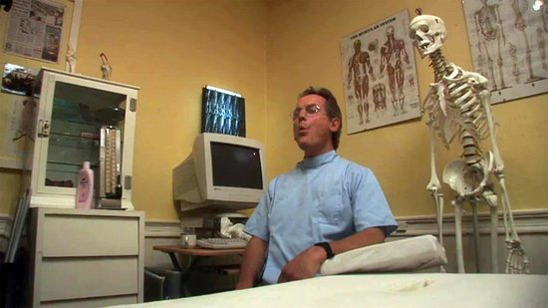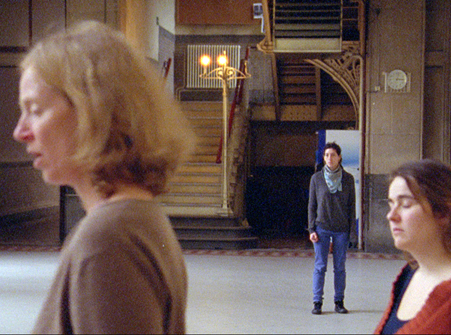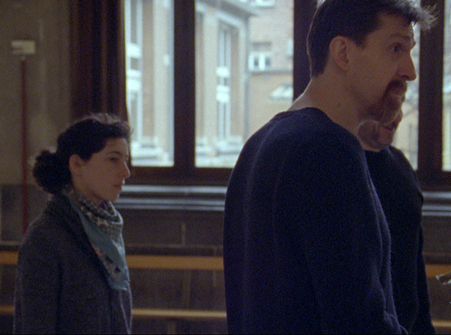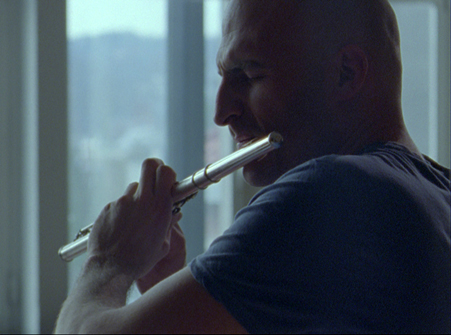 Non-Human Speech & Listening Cameras
Non-Human Speech & Listening Cameras
Vocal Folds (exhibition)
published in Real Time No.116, Sydney, 2013Vocal Folds (curated by Jacqueline Dougherty and installed at Gertrude Contemporary, Melbourne) presents a careful selection of 3 video works which individually and collectively address the human voice in varied ways. The installation—like a notable number of Gertrude Contemporary group exhibitions over the past 5 years—wonderfully grants the visitor access to the material and phenomenal aspects of each work. The ‘white cube’ hasn't been ignored or destroyed: it has simply become invisible in the face of the installed works, which means that the audiovisual content is comfortably and impressively conveyed without interference by inappropriate architectural edifices, inadequate acoustical accommodation, or improper curatorial assumptions of the audiovisual experience. Vocal Folds has refreshingly been conceived as a material occurrence, in accordance with its intention to investigate the material effects of the human voice as a generator of palpable linguistics and discursive abstraction.
Valie Export’s I turn over the pictures of my voice in my head (2008) serves as a critical introduction to these notions. Export’s work is a curious amalgam of linguistic didacticism and visceral scopic spectacle—which for me grants it a somewhat obvious audio-visuality. While this is to a degree typical of Viennese Aktionism and its after-effects, Export’s lugubrious intonation of a convolving Wittgensteinian text seems divorced from the conceit of using a laryngoscope to spectacularise the means of production of her language. For some, this audiovisual merger will intensify the experience (the thrill of inserting scopic and auditory devices into the human body is a longstanding trope of radicalised body art) but I found the work surprisingly monotonal and literal. Regardless, Export’s work posits one recourse to visualising the mechanics of language through the materiality of the vocal apparatus.
Marcus Coates multi-screen video installation Dawn Chorus (2007) creates a dense field of communicative noise by employing British morning bird chatter. The mass tittering of birds is the first thing you hear when you enter Vocal Folds. It’s a frenetic exhausting veil of warbling frequencies and piercing harmonic tones, yet it hangs throughout the three galleries in a non-obtrusive way. 14 video screens are positioned throughout the space at varying heights and angles, inviting you to wander through their arrangement. At any one time, you can hear at most 3 or even 4 birds whistling, but due to the high frequencies of bird sound, it’s quite difficult to locate their position—especially within an enclosed space. After some time, it became apparent that at select moments, one of the onscreen portraits (each of a singular person alone and comfortable in a plain domestic setting) would break into birdsong. But at this precise moment, the video went into hyper sped-up mode, indicating that the ‘birdsong’ I was hearing was in fact humans mimicking birdsong at a slowed-down speed, which was then played back at high-speed to replicate the frequency range of birdsong. Of course, to a bird, it would have sounded more alien than avian— like us listening to a computerised simulation of an Indian call-centre worker reading James Joyce through a fuzz-box and presuming it to be ‘vocalised language’.
Dawn Chorus—possibly unknowingly—recalls a longstanding tradition of how composers have been attracted to the impenetrable vociferousness of birdsong, and the complexity of its multifarious modes, dialects and individualised applications. Beethoven—gifted in hearing music both within his head and in the outside world—allowed birdsong to activate lyrical motifs in his pastoral suites, evoking the sensation of being immersed in the musical crossfire of the outside world. Similarly, Olivier Messiaen—skilled organist and ornithologist—spent innumerable hours meticulously transcribing birdsong patterns from which he elaborated complex rhythmic shapes and dense harmonies to simulate birds’ melodic phraseology. Oskar Sala—inventor of the trautonium and early explorer of the intersection of physics and acoustics—processed and transfigured birdsong tape recordings to render them ‘post-avian’ and hence monstrous in Alfred Hitchcock’s The Birds (1963).
While Dawn Chorus is largely determined by an extant attraction humans have toward avian linguistic code, Manon de Boer’s 2-screen installation one, two, many (2011) treats humans in a similar fashion. Shifting and alternating between 2 screens facing each other, a suite of 3 videos are projected, one at a time, each time on a different screen. One video is a performance by a vocal ensemble in the large reception area of an old building, watched by a handful of visitors; the next is a performance by a solo flautist by himself in a small domestic room; the third has the camera focussed on a wall while a woman’s voice talks about listening to a tape recording of a lecture by Roland Barthes.
In one sense, there’s something very modish about one, two, many. Contemporary art for nearly a decade now has been progressively aligned not only with performance and performance art history (canonised by and through Marina Abramovic’s Seven Easy Pieces), but also by the performative modes, techniques and practices of a wide spray of arts predicated on both traditional and experimental legacies of performing. Music has notably come into the spotlight here, with many a video-art videographer treating composers, musicians and their audiences like anthropologists fascinated with such brethren. Often it’s like David Attenborough studying a Fluxus performance: the artist seems to be pondering “what are they thinking when they’re performing/playing/listening/etc.?”. one, two many falls into this category. As much as I would like to celebrate the rigour of its cinematised ‘deep listening’, I hasten to historically and culturally locate its anthropological tendencies. The roving camera which streams its one-take flow ably conveys the sense of flow and entrancement endemic to the act of listening—but such camerawork technique was well established by tracking shots in Busby Berkeley musicals in the ‘30s, where space was dematerialised to evidence the temporality of listening. Manon de Boer’s camerawork more resembles the base humanist impulse of anthropological documentation: to evidence the human being in front of the lens, hence the palpable presence of their hair, skin, clothing, posture. Through such a procedure, the human becomes eroticised—yet for no direct purpose. (Not surprisingly, this is precisely what impels most ‘experimental/exploratory/extended’ forms of musical improvisation: humanism.)
When the Dardenne brothers stayed within the audible breathing space of Rosetta in Rosetta (1999), they treated her as if they were filming a combatant in a warzone. This intensifies the psychological claustrophobia which terrorises Rosetta throughout the gruelling film. When Heddy Honigmann places her camera literally in the faces of her subjects who endure the playback of songs they used to assuage them whilst working in debilitating warzones, she captures in Crazy (2000) how the sound of music now ruptures their present space with overwhelming memories of the past. From the gasping breath of a frantic teenage in the former, to the silent tears held back by aging men in the latter, the camera is used not to document but to listen. one, two, many doesn’t achieve this, yet—like the Valie Export piece—it affords the opportunity to make these links and consider the wider options of its audiovisual practice.
Yet I’m frankly not confident that visual art professionals are entirely attuned to what I’m saying here. All 3 videos exhibited in Vocal Folds contain enough visual beauty—from the abject to the transcendental—to satiate the intelligentsia. And I’m equally sceptical that sound/music professionals are interested in the intellectual ramifications of their experimental practices. These videos contain soundtracks and sound designs implicitly opposed to conventional audiovisual cinema practices, thus emboldening those who think audiovision is best discussed as a radical or progressive intermedial venture. Vocal Folds bravely intimates that language can collapse or evolve into a supra-form through the materiality of the voice (something one can imagine Cathy Berberian or Joan La Barbara espousing) but I feel most people will stop just there. The Vocal Folds exhibition for me opened up possibilities from that point, to welcome how the depiction of humans engaged in making or listening to sound or music can illustrate an escape from humanist inscription.
Text © Philip Brophy. Images © the artists Valie Export, Marcus Coates & Manon de Boer.

